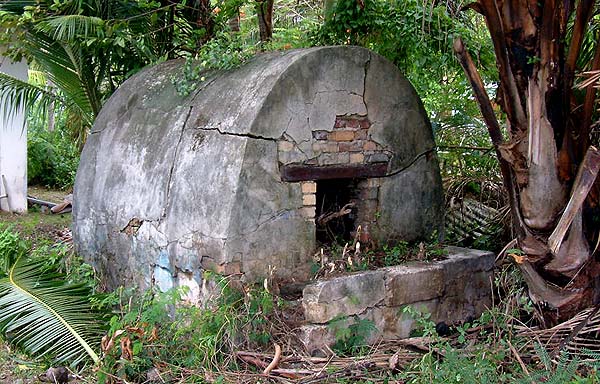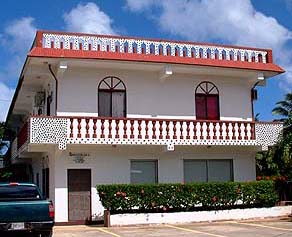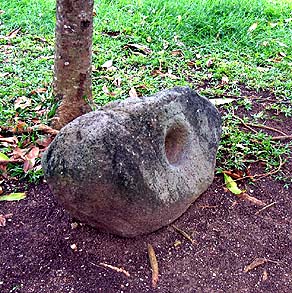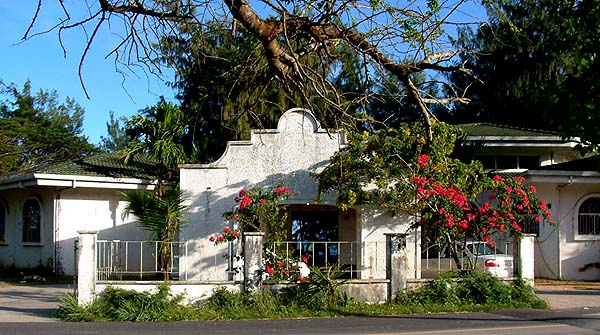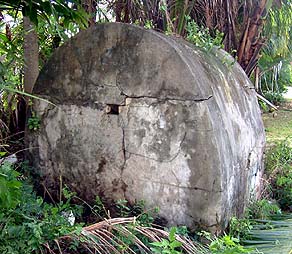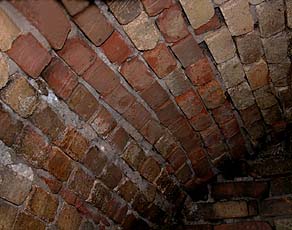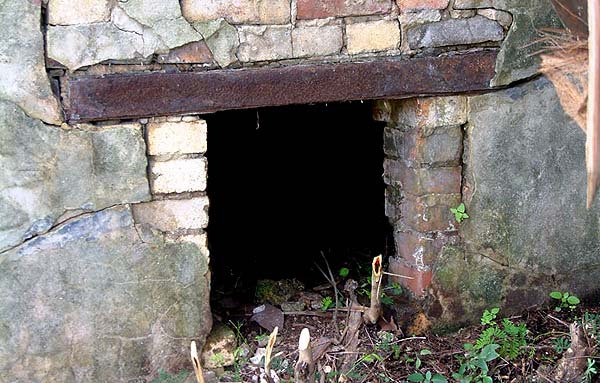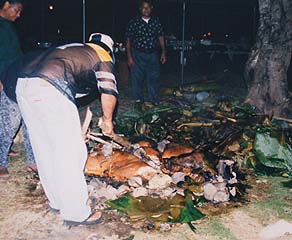 |
 |
 |
|||||
|
|
|
|
|
|
|
|
|
|
|
|||||||
|
|
|
|
|
|
“The hotnu, as we call it here in the island, is an oven made primarily of bricks,” Ben explains, “because bricks hold heat better than any other material. These ovens were made of bricks by a couple of families here in the village. One is the family of Pedro Taitano, better known as don Pedro Parau, and the other one is the Igitol family known as don Pablo Igitol."
|
||
|
|
||
"Hotnu is a Spanish influence, originally. The Spaniards were here for more than 400 years, and their influence is very prominent on the island. I can safely say that at least 60% of our language is made of Spanish and the rest, a much smaller percentage, is Chamorro. We don’t know how to count in Chamorro anymore. We don’t know how to say the days and the weeks in Chamorro. They’re gone because of the tremendous impact of the Spaniards’ influence in the island. "Now a lot of the architecture resembles the Spaniards’. In fact, the Spaniards’ architectural design continues to be number one. It’s probably more a result of convenience, as the design was here and it was easy to implement that design. Including the hotnu."
|
|
|
The name “Taitano” reflects a distinctly Chamorro influence, and Mrs. Louisa Sablan tells its story: “This took place a long, long time ago, here on the island of Saipan. A long time ago, the people did not have last names. A long time ago, the ancestor called all the people together to give them their names. From then on, people have such names as Sablan, Mangalonia, and Taitano. "The family with the name of Taitano were the last people that came, and they ran out of names, so the ancestor, back when they were giving these names, they said ‘Let me give you this name, Taitano.’ And that’s how this family today has that name."
|
|
|
|
|
"Do you understand what is the meaning of Taitano? Tano means 'land' in Chamorro. Tai is root word that means' negative,' 'no,' 'nothing.' Today, the Taitano family name means ‘the people with no land, or no homestead; no land at all.' "This legend was passed on from my mother, and her mother, and is passed on. Sometimes I asked my mom, ‘How come your name is Taitano?’ And then my mother would tell me the story of the Taitano last name, and how it came about." And when the Chamorros returned to Saipan after decades under Spanish rule on Guam, they brought the hotnu technology with them.
|
||
|
|
||
"When I was growing up," Ben recalls, "hotnu was a main event. For example, if there was a wedding, the mentor of the wedding would buy sacks and sacks of flour, and usually Crisco grease-type for mixing. They would get salt and mix it, and we young kids—because we’re young and strong and last long—we would help the women. Mostly women do these things. "I remember mixing cakes and massaging the bread to cook in this oven. When you roll the dough—‘kneading,’ they call it—you massage it. We call it yaka, which means ‘to mix,’ because it’s a large dough, and it takes force and mixes with our sweat and that makes it taste better."
|
|
|
"The men put the fire in the hotnu and later on, the women bring the fire up a little bit and then feel with their hands, and when they think that it ’s the right heat, they clean out all the coals to put the bread in. They take all of the coals out so that it’s clean. We also use banana leaves to clean out the ashes and charcoal, so that it doesn’t go in the bread. You see, at this point, the oven is hot all by itself. "I remember cutting wood, bringing wood—this big tangan tangan wood that we had to carry on our backs. Up to about six inches across, these logs, and then we would chop them down to the size of the oven, the hotnu. The older men would start the fire and when the fire simmered down, we would clean out all the charcoal and the ashes and put the bread inside."
|
|
|
|
|
"The main hole, we would cover it with plywood or other kinds of wood, mainly plywood, already designed for that, and we would put a stick there so it doesn’t fall off. There’s an opening in the back, to let the heat out so the bread doesn’t get burned, and every so often they would open it and peek in, and if the color was right, they would take it out and repackage it for the wedding. "Cake was the most fun because we would use hand blenders, made by the old ladies. They would get stainless steel rods from the dump, clean them up and shape them into blender-type things, and we would be whipping it, whipping it until the batter rose. It was wonderful. I remember it very vividly today."
|
||
|
|
||
"The hotnu is one way of cooking, but most of our meat is not cooked in that. It’s strictly for bread and for cake. If we’re going to cook meat or fish, the Carolinian would dig down and put the fire down in the ground so the ground can hold the heat. "We build the fire first and we throw in rocks and get the rocks to heat up. Then when the fire diminishes, we put in coconut stems so the meat does not touch the ashes or the charcoal and the rocks around it. In some cases the meat is wrapped in taro leaves or in banana leaves. In other cases, the meat is exposed: you throw it down and then you cover it with leaves, banana leaves or taro leaves, and then cover it with gunny sacks. And that’s the way we cook."
|
|
|
|
|
"But the hotnu, it is a very distinct Chamorro impact on this village," Ben concludes.
|
||
|
|
||
|
|
|
|
|
|

|
| Tanapag Home | Map Library | Site Map | Pacific Worlds Home |
|
|
|
|

|
|
|
|||
| Copyright 2003 Pacific Worlds & Associates • Usage Policy • Webmaster |
|||
